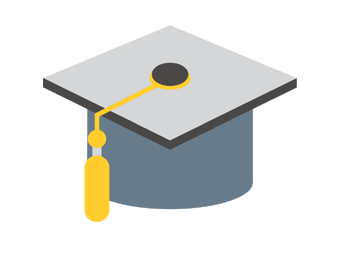PATENT BAR EXAM REQUIREMENTS
The Definitive Guide
The USPTO published an updated version of the General Requirements Bulletin issued on January 2024. This guide is based on the new updates.
Please be sure to refer to the Official Bulletin for the final say in whether you qualify to sit for the patent bar exam.
You don’t need to be a lawyer in order to meet the requirements to sit for the United States Patent and Trademark Office Registration Exam. However, in order to qualify for the Patent Exam, you will need at least a bachelor’s degree in one of the specified fields of science or engineering.
An individual with a law degree, but without the proper education or training in science or engineering will not meet the patent exam requirements.
In addition to meeting the technical qualifications, every individual will have to show they possess good moral character and meet the citizenship requirements.
There are four main categories you may qualify under to sit for the patent registration examination. They are listed out here for your convenience (but you should plan to review the official USPTO bulletin for the most updated and detailed information).

CATEGORY A
Bachelor’s Degree, Master’s Degree or Doctor of Philosophy Degree in a Recognized Technical Subject.
This category was changed significantly. Several degrees were added during the October 2021 publication of the Official Bulletin. In addition, you are not limited to only a Bachelor’s degree, but can also have a Master’s or a Ph.D. in one of the listed degrees.
The requirements to sit for the patent exam will be met if you have a degree in one of the fields listed below as evidenced by an official transcript.
Computer Science (Must be from an accredited program)
Engineering:
- Aerospace Engineering
- Aeronautical Engineering
- Agricultural Engineering
- Bioengineering
- Biomedical Engineering
- Ceramic Engineering
- Chemical Engineering
- Civil Engineering
- Computer Engineering
- Electrical Engineering
- Electrochemical Engineering
- Electronics Engineering
- Engineering Physics
- Environmental Engineering
- General Engineering
- Genetic Engineering
- Geological Engineering
- Industrial Engineering
- Marine Engineering
- Materials Engineering
- Mechanical Engineering
- Metallurgical Engineering
- Mining Engineering
- Nuclear Engineering
- Ocean Engineering
- Petroleum Engineering
- Textile Engineering

Science:
- Biology
- Biochemistry
- Biological Science
- Biophysics
- Botany
- General Chemistry
- Genetics
- Materials Science
- Microbiology
- Molecular Biology
- Neuroscience
- Organic Chemistry
- Pharmacology
- Physics
Technology:
- Electronics Technology
- Food Technology
- Marine Technology
- Textile Technology
Note that the Office wants an official transcript including the university stamp or seal. The transcript may be sent by you (the applicant) or sent through the university. A diploma or a copy of a transcript will not be accepted.
In some cases the USPTO will accept degrees that demonstrate equivalence to one of the degrees listed here for Category A. For example, Materials Science and Engineering may be equivalent to a Materials Science degree. The Office will have the final say in determining whether the transcript demonstrates equivalence.
If you do not meet the requirements of Category A, then you may still qualify under Category B or C.
CATEGORY B
Bachelor’s Degree, Master’s Degree or Doctor of Philosophy Degree in Another Subject.
Category B relies on a degree in a subject not listed under Category A.
You may still meet the technical qualifications without one of the degrees listed in Category A. You may qualify based on scientific and technical training equivalent to a degree in one of the subjects listed in Category A.
This includes a review of the college coursework you have completed. One of the following sets of coursework may be substituted for one of the degrees listed in Category A:
Option 1: 24 semester hours in physics (only physics courses for physics majors will be accepted).
Option 2: 32 semester hours in a combination consisting of the following: Eight semester hours in a combination of chemistry and physics, with at least one course including a lab, and 24 semester hours in biology, botany, microbiology, or molecular biology (only courses for science or engineering majors will be accepted).
Option 3: 30 semester hours in chemistry (only chemistry courses for chemistry majors will be accepted).
Option 4: 40 semester hours in a combination consisting of the following: 8 semester hours in a combination of chemistry, physics, and/or biology, with at least one course including a lab, and 32 semester hours of chemistry, physics, biology, botany, microbiology, molecular biology, or engineering (only courses for science or engineering majors will be accepted).

In order to qualify to sit for the registration examination under Category B, you will need to send in official transcripts along with course descriptions from the school’s catalog.
The course description must be applicable the same year the course was taken. Descriptions must include copies of the catalog cover page with the year showing, any pages showing the requirements for the major, and pages describing the courses the Office should consider. Only courses with a grade better than a ‘C-’ will be accepted.
While most universities use a semester hour standard based on a semester of 15 to 18 weeks, credits may be granted to those earned at a university with less than a typical 15 to 18 week semester.
Quarter-hour or trimester hour conversions can both be converted by multiplying the quarter or trimester hours by 2/3.
The Office will accept Certified English translations of transcripts, course descriptions, and other foreign language documents.
You may also send in other training including experience or other expertise along with other education and military service.
Specifically, you may send in objective evidence in scientific and technical training that is equivalent to that of one of the degrees listed in Category A. In this case, the burden is on you to establish possession of sufficient training and expertise equivalent to a Category A degree.
Note that the patent office has the final say as to whether or not you may sit for the registration exam.
CATEGORY C
Practical Engineering or Scientific Experience.
Category C relies on practical engineering or scientific experience by demonstrating that the individual has passed the Fundamentals of Engineering (FE) test.
The FE test is a test of engineering fundamentals. The FE test is developed and administered by a State Board of Engineering Examiners in each State or comparable jurisdiction. It is not administered by the USPTO.
To qualify to sit for the patent exam under Category C, you must send in the official results of the FE test and include an official transcript showing the award of a Bachelor’s degree.

CATEGORY D
Design Patent Practice Only.
To qualify under this category, you need a Bachelor’s Degree, Master’s Degree or Doctor of Philosophy Degree in a Recognized Design Subject. Here are the subjects that qualify you for this category:
- Architecture
- Applied Arts
- Art Teacher Education
- Fine/Studio Arts
- Graphic Design
- Industrial Design
- Product Design
The degree must be from an accredited United States college or university. You must submit an official transcript from the college or university.
If you don’t have one of the exact degrees listed here, if you can show that the equivalent of one of the degrees was awarded then you may still be eligible. You will need to submit an official transcript and show how the degree you received it the equivalent to one of the above.
If you apply under Category D, then upon passing the registration examination, you can only practice patent law in regards to design patent matters only.
ELIGIBILITY OF ALIENS
Only U.S. citizens or permanent U.S. residents can be registered to practice law before the USPTO.
The patent bar is not administered to aliens who do not reside in the United States. An alien residing in the United States may apply to take the exam. However, to be admitted to take the patent bar, you must establish that your recognition is consistent with the capacity of employment authorized by the United States Citizenship and Immigration Services (USCIS).
The Canadian Intellectual Property Office offers substantially reciprocal privileges to those already admitted to practice before the USPTO. However, that is the only patent office that currently offers this arrangement.
If you meet the technical qualifications but are a non-immigrant alien then you may be given limited recognition before the USPTO provided recognition is consistent with the capacity of employment or training authorized by the USCIS.
INELIGIBLE APPLICANTS
The meaning of good moral character and reputation.
There are two main triggers for ineligibility to sit for the patent bar exam despite meeting the other qualifications.
The first one is for convictions including, but not limited to any confession to a crime, a verdict, or judgment finding a person guilty of a crime. If you have been convicted of a crime then you can still apply, but will need to send in an additional fee. The Director of the OED will determine if you have produced proof of reform and rehabilitation.
The second one is for disciplined professionals. If you have been disbarred from the practice of law or from any other profession or resigned a professional license due to a disciplinary proceeding, then you are ineligible to apply to take the patent bar exam for five years from the date of disbarment or resignation. If you are suspended from the practice of law or another profession, then you may not apply until your suspension is over.
If you are previously denied for lack of good moral character and reputation then you may not reapply for registration for two years after the date of the decision.
FAQS ABOUT THE PATENT BAR REQUIREMENTS
Section 6
Who Can Take the Exam?
The Patent Bar is limited to scientists and engineers with the degrees posted above or a background showing technical skills in science or engineering. In order to write and prosecute patent applications, you must be skilled within a specific technology.
Why These Degrees?
These degrees are representative of the type of background required to understand many different inventions. As a patent practitioner, you will often help inventors file a patent application and navigate the patent prosecution process put forth by the US Patent and Trademark Office.
There are basically two main pathways. One is the pathway of an engineer and the other is the pathway of a scientist. You don’t need experience or coursework in both, just one will suffice. As long as you pass the patent bar then you will be registered as a patent practitioner.
Is US Citizenship Required?
You must be a U.S. citizen who resides in the U.S in order to qualify. However, aliens residing in the U.S. may apply. They should send in evidence of employment authorized by the USCIS (United States Citizenship and Immigration Services). Please check the official bulletin published by the USPTO for further details.
What if I Have a Law Degree, but No Science or Engineering Background?
In order to become a registered patent practitioner, you must qualify for the Patent Bar exam. Without one of the degrees listed above or a background in science or engineering, you do not qualify.
Therefore, in order to take the exam, you must gain a degree in one of the qualifying fields, take the required coursework outlined above, or take the FE exam.
What if I Don’t Have a Law Degree?
You don’t need a law degree to become a patent practitioner. If you’ve passed the Patent Bar exam without a law degree then you will become a registered Patent Agent. As a registered Patent Agent you can represent clients before the patent office writing and prosecuting patents. Only Patent Attorneys (those with a law degree who are eligible to practice law) may help with patent litigation.
Getting a law degree later is always an option, but many scientists and engineers wind up working in the field as Patent Agents. Whether or not you have a law degree has no bearing on taking the Patent Bar exam.
What is the Best Major for Becoming a Patent Pracitioner?
Electrical and mechanical engineers are in the highest demand. Life sciences degrees like biochemistry and molecular biology are also in demand although these typically require higher degree levels (like a Master’s degree or Ph.D.).
Realistically, any major on the list of requirements from the USPTO will work. There is no one best degree.
In order to gain employment as a patent practitioner, you must understand the technology you will be drafting patent applications in. You need to understand the prior art in order to evaluate whether the invention will be allowed or rejected. You need to understand it well enough to argue how the invention is patentably distinct from the prior art.
You will be drafting patents in your area of expertise. So if your background is in biochemistry, you’ll likely work with inventors who are on the cutting edge of a specific field in biochemistry. The inventions you’ll be working toward protecting will deal with biochemistry or possibly other scientific advancements in the field of biology.
In order to be the most employable your background should match an area where there are a lot of advancements being made or one where there are few people with the right background. Those are the fields where people are needed to help patent inventions.
An engineering degree is highly valued, but if you have the right background to sit for the Patent Bar exam, you should be able to gain employment in that particular field. It’s just a matter of the right opportunity coming around.
If you’re in a niche or specialized field the best thing to do is to research job posting sites online. Determine if firms or companies are hiring that type of patent practitioner in a specific location you’re interested in. That will give you an idea as to whether or not you can gain employment easily in this particular field or if it will be more difficult. You can decide from there whether this is the right move for you to make.
If you have a law degree in addition to a science or engineering background and you pass the patent bar exam then you will be registered as a patent attorney.

Is There any Certain Minor to Consider?
No, just take a minor that supports your major and/or is something you’ll enjoy.
Is it Best to Take the Patent Bar Exam in School (Like Law School or Graduate School) or After?
The sooner you can take the exam the better. As long as you meet the requirements to pass the exam, you should start preparing. It’s possible to pass this exam over summer if you study diligently or even over a few breaks (like summer, winter, and spring break) if you can’t quite squeeze it in over one.
Patent Agent and Attorney Salary Ranges
According to research on PayScale.com, the average pay for a Patent Agent is $100,733 a year.
If you contrast the average range with the average pay for those in science and engineering fields, you will see that a career as a Patent Agent is usually more lucrative. Often by as much as $20,000 to $30,000 more per year.
And keep in mind that if you choose to sit for the Patent Bar exam and become a Patent Agent, you may decide at a later date to attend law school. Once you meet the criteria for an attorney, then you will be able to change your status with the USPTO from Patent Agent to Patent Attorney.
Further research on PayScale.com shows that the average salary of a patent attorney is around $138,426. In a survey conducted by the American Intellectual Property Law Association (AIPLA), the average patent attorney’s salary was much higher than those reported by PayScale. According to AIPLA, the average salary of their members (all patent practitioners) was over $180,000 a year.
At the top of the pay scale are partners in private firms who reportedly earn about $300,000 a year according to statistics by the AIPLA in a survey of its members.
Associates in private firms will make considerably less. The AIPLA reports that its associates earn an average of $125,000 a year during their first year. PayScale reports that the average starting salary for a patent attorney with between 1 and 4 year of experience is $90,000 to $140,000 a year.
Keep in mind that you do need a background in science and engineering to become a patent attorney. For this reason, many attorneys lack the credentials to practice patent law, which is one reason why the field is more in-demand than many other areas of legal practice.
A Bachelor’s degree in science or engineering will meet the criteria to take the patent bar exam, but some firms will expect a higher degree (i.e. graduate work) and/or related work experience. In addition to writing and prosecuting patent applications, as a patent attorney, you may also prepare for infringement cases and offer legal advice concerning the litigation.
As you can see, patent practitioners, whether agents or attorneys, earn a high salary.
How can I study for the Patent Bar Examination?
The best way to prepare yourself for the exam is to take a patent bar review course. The test covers the Manual of Patent Examining Procedure or MPEP which is a massive document complete with all the laws and rules for practicing patent law.
The exam consists of two three-hour sessions. There are 100 multiple choice questions in all. The pass rate is very low. Often less than half of those who sit for the exam pass it.
We offer a review course that is affordable and easy to navigate. The course covers exactly what you need to know to pass and is based on the currently tested source materials.
You can complete the course online so it is very convenient. Many of our clients pass the exam in 2 to 4 months. Once you pass the patent exam, you will be able to assist patent applicants before the United States Patent and Trademark Office.
Additional Resources
- About the Patent Bar Exam
Uncover what makes the Patent Bar exam so challenging. - Why Take the Patent Bar?
Learn why many are taking the patent bar.
- Patent Bar Review Course
Find out whether or not you meet the requirements to sit for the patent bar exam. - Patent Bar Exam Strategies
Learn tips and strategies for passing the patent bar exam with less stress.
